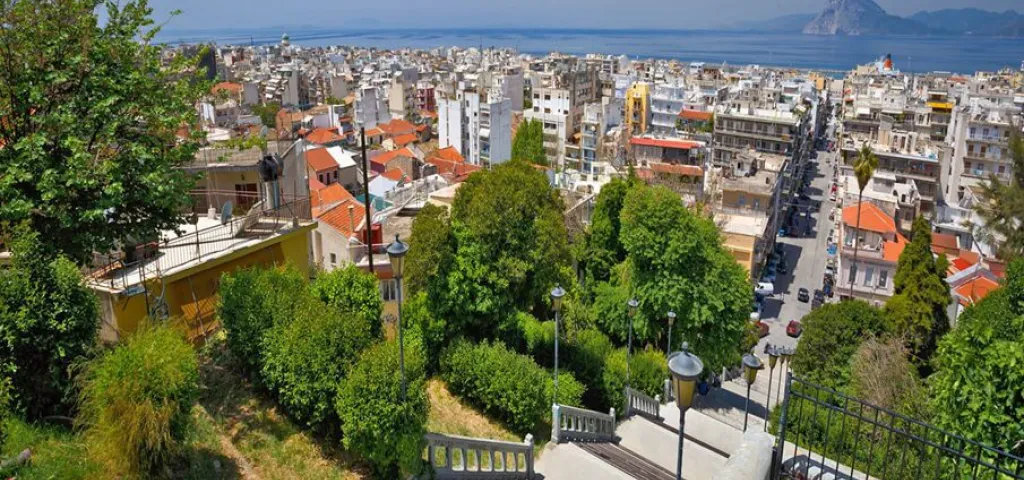
Queen of the Greek Carnival
The third largest town in Greece, Patras owes most of its tourist development to the busy port that serves ferries to the Ionian islands and Italy.
The beautiful beach promenade of Patras, the interesting historical sites, the joyful Carnival in February/March and the vivid nightlife attract many visitors to this city.
The most important site in Patra is the Medieval Castle, located above the Old Town and offering a panoramic view.
The Church of Saint Andrew is also worth to visit as this is the protector of Patras and he is believed to be a miracle-working saint. In short drive from Patras are nice locations to visit, such as the Ancient Site of Olympia and the picturesque town of Nafpaktos.
Also you can visit the Roman Odeum, the Roman Aqueduct, the modern Archaeological Museum of Patras, the Charilalos TrIkoupis Bridge (the largest cable bridge in Europe at Rio) and the Mycenaean Settlement of Voudeni (Mycenaean Cemetery).
Enjoy the magnificent sunsets from the 193 stairs of Agios Nikolaos, with majestic view of Molos and Patras Gulf.
Wander through the straits of the Upper Town between neoclassical mansions and travel to another era.
Enjoy shopping on the main pedestrian street of Riga Ferraiou and enjoy dinner at one of the city's unique restaurants.
Every night in Patras is special as it is a city that never sleeps. From picturesque taverns and the best nightclubs in town, the locals know how to make you feel at home.
The coastline of Achaia gives many options for moments of relaxation on its beaches that stretch for many kilometers.
The accessibility to the city of Patras is easy, from the north through the motorway of Ionia Odos and the Rio-Antirio (Charilaos Trikoupis) bridge and from the east through the motorway of Olympia Odos. Also, the connection with abroad through Athens International Airoport “Eleftherios Venizelos or through the airport of Araxos, which is just 45 kilometers from the city center with the possibility of international flights.
The city is also approached for wine tourism as the famous and historic winery Achaia Claus is based here. In this area is kept the oldest wine in Greece, the old Mavrodaphne of 1873.
Achaia Claus over the years, (founded in 1861), has been honored with many internationally renowned awards.
Finally, we cannot fail to mention the Patras Carnival! It is the largest and oldest carnival event in Greece. The events include the opening and closing ceremony, the Carnival of the Little Ones, the game of hidden treasure, the Parade of Chariots, the Bourboulia and of course the Night Podarati and the Grand Parade.
City Sights
Medieval Castle
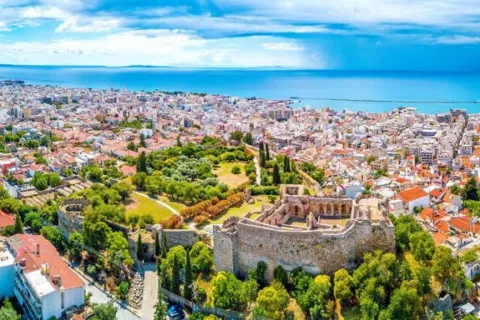
The Patras Castle was built around the mid-6th century A.D above the ruins of the ancient acropolis of the city of Patras, on a low outlying hill of the Panachaiko Mountain and ca. 800 m from the sea.
The castle covers 22,725 m² and consists of a triangular outer wall, strengthened by towers and gates and further protected originally by a moat, and an inner compound on the northeastern corner, also protected by a moat.
The first castle on the spot was built by Byzantine Emperor Justinian I after the catastrophic earthquake of 551, re-using building material from pre-Christian structures. One of these spolia , the torso and head of a marble Roman statue, became part of the city's folklore, a sort of genius loci. It is known as the "Patrinella", a maiden who is supposed to have been transformed into a man during Ottoman times, guards the city against disease and weeps whenever a prominent citizen of Patras dies.
The fort remained in constant use thereafter, even until the Second World War. In the Byzantine period, it was besieged by Slavs, Saracens, Normans and many others, but it never fell. In particular, the successful repulsion of a great siege of 805 AD by the Arabs and the Slavs was attributed to the city's patron saint, St. Andrew (Agios Andreas).
In 1205, in the aftermath of the Fourth Crusade, it was taken over by the Franks, who strengthened it further, opening a moat on all three sides. In 1278, the Principality of Achaea pawned it to the local Latin (Catholic) Archbishop, while the Pope leased it to the Venetians for five years in 1408. The Latin Archbishop remained in possession of the castle until 1430, when it was taken by the Despot of the Morea and future last Byzantine emperor, Constantine Palaiologos, who made extensive repairs to its walls. The castle fell to the Ottoman Turks in 1458, and remained one of their main seats of power in the Peloponnese throughout the Τourkish Rule (Tourkokratia). The Venetians took the castle in 1687 during the Morean War, and kept it until the Morea was retaken by the Turks in 1715.
Following independence, the castle remained in use by the Greek Army until afte World War II. In 1973, the castle was turned over to the 6th Ephorate of Byzantine Antiguities.. It is used nowadays for cultural events, especially during summer, and features a theatre with a capacity of 640 seats.
Roman Odeum
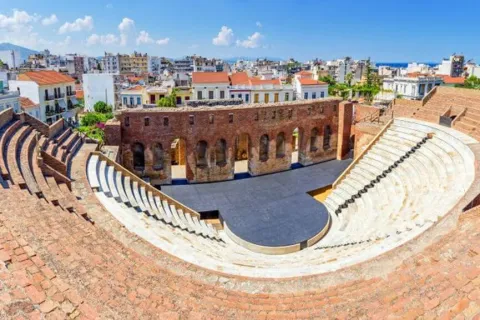
The Roman Odeum is located on the west side of Patra. It was built before the Odeum of Athens in front of which stands the statue of Apollo. The Odeum of Patras was severely destroyed by successive invasions, wars, and earthquakes. It was almost buried under the remains of other buildings and ground. It was in 1889 when the Odeum was found by accident while some workers were digging up the ground for the construction of the port.
The restoration of the Odeum continued till 1956 when it regained its original shape. Along with its restoration process, the nearby areas were declared as archaeological sites. The Roman Odeum today functions as the chief venue for Patras International Festival held every summer and other cultural events. The Odeum has a seating capacity of 2,300 people with all the basic facilities of a theatre such as hollow, orchestra, proscenium, scene and wings.
Church of Saint Andrew
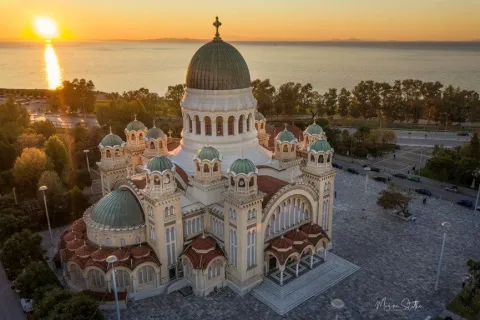
The church of Saint Andrew (Agios Andreas) is the most important church in Patras, as this is the patron saint of the town. This modern church was founded in 1908 by King George I on the site of a former Byzantine chapel that existed there since the 1st century AD. It is said that the church has been built on the site where Saint Andrew, the student of Jesus Christ, was crucified by the Romans in 66 AD. Close to the church, there is the "spring of Saint Andrew", which pours out holy water.
Archaeological Museum of Patras
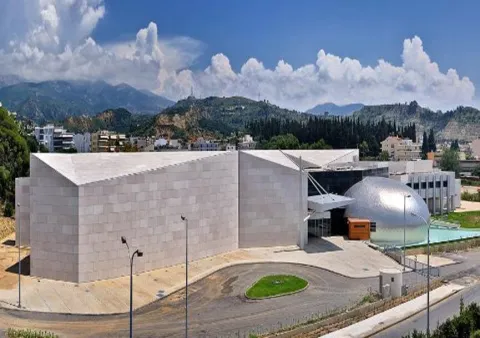
The Archaeological Museum of Patras is the second-largest museum of Greece. Τhe museum opened in July 2009.
Built on a 28,000-square-metre (300,000 sq ft) plot of land, with 8,000 square metres of interior spaces. The area surrounding the museum comprises a 500-square-metre (5,400 sq ft) pool, a shiny metallic dome and greenery. In the near future, the vacant land next to the museum will be turned into a cultural park.
It houses collections about the history of Patras and the surrounding area from prehistory to the end of Roman times. The museum was designed by Bobotis+Bobotis Architects with an original cost of 21.5 million euros that ended up at a total of 25 million. It was originally planned to open in 2006, when Patras was the cultural capital of Europe, but despite the construction being ready, the structure remained empty, with the opening being delayed several times.
The museum has four thematic sections, three of which are permanent and one is periodic. The periodic section will be hosting various exhibitions around the year. According to the archaeologists of the 6th Antiquity Conservancy, the 70% of the items exhibited are seeing the light of day for the first time in the past thirty years.
Faros (Ligthhouse) of Patras
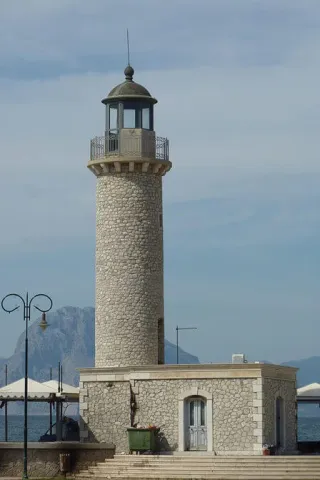
Faros of Patras is a lighthouse and landmark of the Greek city of Patras. It is situated on the seafront (at the beginning of Trion Navarchon street), opposite the temple of Saint Andrew.
The first wooden lighthouse of Patras was built in the dock of Agios Nikolaos in 1858 and was destroyed by a storm in 1865.
The old stone lighthouse was built in 1878. It covered a surface of 4-5 square meters, while its height was 17 meters.[4] It was demolished in 1972 in the period of the military junta during the port's modernization.
In 1999 the coastal zone council decided to rebuild the lighthouse in a southern location near Saint Andrew's cathedral.
The reconstructed Patras lighthouse does not have a maritime usage but is one of the city's symbols and main sights. In the ground level there is a café – bar – restaurant.
Bridge “Charilaos Trikoupis”
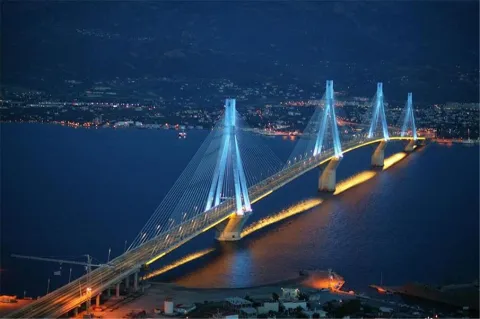
The Rio–Antirrio Bridge (officially the Charilaos Trikoupis Bridge), is one of the world's longest multi-span cable-stayed bridges and longest of the fully suspended type.
It crosses the Gulf of Corinth near Patras, linking the town of Rio on the Peloponnese peninsula to Antirrio on mainland Greece by road.
It opened one day before the Athens 2004 Summer Olympics, on 12 August 2004, and was used to transport the Olympic flame.
The 2,380-metre-long (7,810 ft; 1.48 mi) bridge dramatically improves access to and from the Peloponnese, which could previously be reached only by ferry or via the isthmus of Corinth in the east.
Its width is 28 m (92 ft)—it has two vehicle lanes per direction, an emergency lane and a pedestrian walkway.
Its five-span four-pylon cable-stayed portion of length 2,252 m (7,388 ft) is the world's third longest cable-stayed deck; only the decks of the Jiaxing-Shaoxing Sea Bridge in Shaoxing, China and the Millau Viaduct in southern France are longer at 2,680 m (8,790 ft) and 2,460 m (8,071 ft), respectively.
However, as the former has a shorter length of main span (the length of the main span is the most common way to rank cable-stayed bridges, as the size of the main span does often correlate with the height of the towers, and the engineering complexity involved in designing and constructing the bridge) and as the latter is also supported by bearings at the pylons apart from cable stays, the Rio–Antirrio Bridge deck might be considered the longest cable-stayed "suspended" deck in the world.
This bridge is widely considered to be an engineering masterpiece, owing to several solutions applied to span the difficult site. These difficulties include deep water, insecure materials for foundations, seismic activity, the probability of tsunamis, and the expansion of the Gulf of Corinth due to plate tectonics.
Charilaos Trikoupis was a 19th-century prime minister of Greece who suggested building a bridge in the current location but Greece's finances at the time didn't permit its construction.
The bridge was planned in the mid-1990s and was built by a French-Greek consortium led by the French group Vinci SA which includes the Greek companies Hellenic Technodomiki-TEV, J&P-Avax, Athena, Proodeftiki and Pantechniki. The suspension of the blue decorative lighting was announced by the company due to the ongoing electricity crisis in Europe but also to be in line with the company's environmental strategy. The bridge's carbon footprint has been reduced by 84.5% from 2015 to 2022.
The lead architect was Berdj Mikaelian. Site preparation and dredging began in July 1998, and construction of the massive supporting pylons in 2000. With these complete in 2003, work began on the traffic decks. Steel fabrication was undertaken by Cleveland Bridge & Engineering Company.
On 21 May 2004 the main stage of construction was completed; only equipment (sidewalks, railings, etc.) and waterproofing remained to be installed.
The total cost of the bridge was about €630 million, funded by Greek state funds, the consortium, and loans by the European Investment Bank. It was finished ahead of its original schedule, which had foreseen completion between September and November 2004, and within budget. Other sources suggest the final cost was €839 million.
USEFUL INFORMATION
- USEFUL TELEPHONES
-
EMERGENCY CALL 112
FIRST AID 166
POLICE 100
FIRE DEPARTMENT 199
RED CROSS PATRAS +30 2610 277833
FIRST AID STATION PATRAS +30 2610 277386
UNIVERSITY GENERAL HOSPITAL OF PATRAS +30 2613 603000
PATRAS GENERAL HOSPITAL “AGIOS ANDREAS” +30 2613 601000
PATRAS BUS STATION (ΙΝFORMATION – TICKETS OFFICE) +30 2610 623886
PATRAS RAILWAY STATION +30 2610 639108 & +30 2610 274180
RADIOTAXI PATRAS 18300
TAXI EXPRESS PATRAS +30 2610 450000
APOLLO THEATER (TICKETS OFFICE) +30 2610 273613 - PATRAS HOTELS
-
ADONIS HOTEL +30 2610 224213
ASTIR HOTEL +30 2610 277502
GALAXY HOTEL +30 2610 275981
MY WAY HOTEL +30 2610 623131
THE BOLD TYPE HOTEL +30 2610 220012

